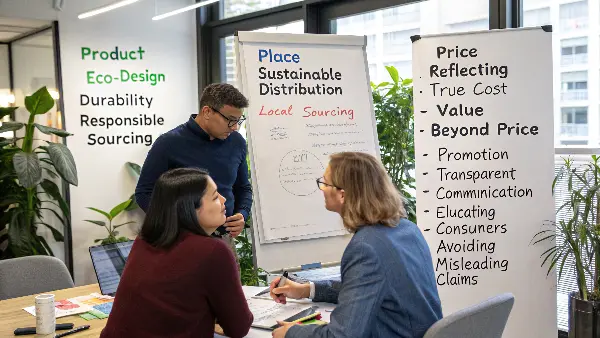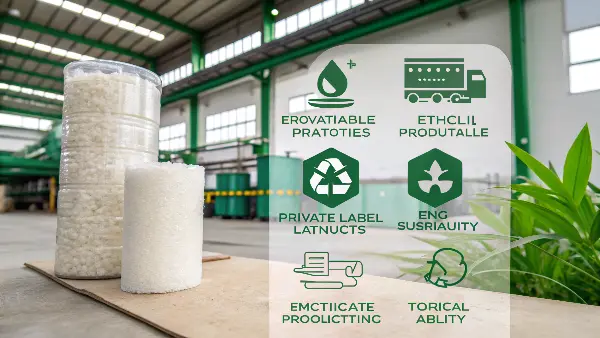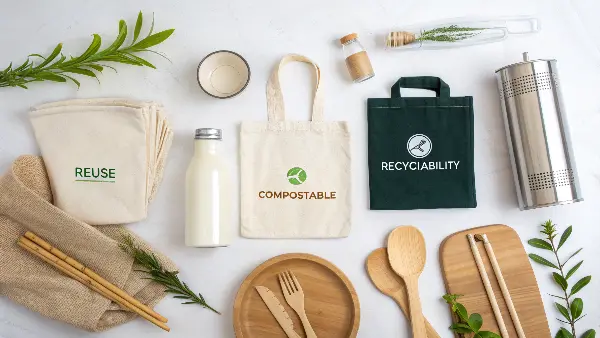Building a unique sustainable brand feels overwhelming sometimes. You need quality eco-products that stand out, but finding reliable, customizable options is hard. Private labeling offers a clear path forward.
Partnering with a supplier like Ecosourcecn for private label eco-products lets you leverage certified materials, customization options, and expert guidance. This helps you create a distinct, trusted sustainable brand aligned with your values and customer expectations.
Creating a brand that truly reflects your commitment to sustainability is a journey. It goes beyond just selling an eco-friendly item; it’s about building trust and communicating your values effectively. For specialists like Jacky, finding the right partner to bring this vision to life through private labeling is crucial. At Ecosourcecn, we understand this deeply. We work closely with businesses worldwide to navigate the complexities of sourcing, certification, customization, and logistics for sustainable products. Let’s explore how you can build your brand with private label eco-products.
How Can You Ensure Your Private Label is Truly Sustainable?
Consumers are wary of greenwashing, and rightly so. Using labels that aren’t genuinely eco-friendly can damage your brand’s credibility. How do you ensure your labels match your product’s sustainability?
Sustainable labeling involves choosing eco-friendly materials (recycled paper, FSC-certified, compostable adhesives). Use non-toxic inks (soy/vegetable-based). Minimize label size. Clearly communicate disposal instructions (recyclable/compostable with product) to guide consumers.
The label itself is a critical component of your sustainable product presentation. It’s often the first thing a customer interacts with, and it needs to align with your eco-message. Making a label sustainable involves several considerations beyond just the appearance. We need to think about the materials used, the printing process, the adhesives, and even the end-of-life plan for the label itself.
Key Elements of Sustainable Labeling:
- Material Choice: Select materials with lower environmental impact. Options include:
- FSC-Certified Paper: Guarantees the paper comes from responsibly managed forests.
- Recycled Paper: Uses post-consumer waste, reducing the need for virgin resources. Look for high post-consumer waste (PCW) content.
- Compostable Materials: Such as PLA films or specific paper types designed to break down in composting environments (ensure certification like EN13432).
- Inks and Adhesives: Conventional inks can contain volatile organic compounds (VOCs) or heavy metals. Opt for:
- Vegetable-based or Soy-based Inks: These have lower VOC content and are derived from renewable resources.
- Water-based Inks: Another lower-impact alternative.
- Eco-Friendly Adhesives: Choose adhesives that are either recyclable or compostable, matching the substrate and the product’s end-of-life. A recyclable product with a non-recyclable label adhesive can contaminate the recycling stream.
- Minimalist Design: Reduce the amount of material used. Smaller labels consume fewer resources. Simple designs often require less ink coverage as well.
-
Clear Disposal Guidance: This is vital. Tell the consumer exactly what to do with the label and packaging. Is the label removable? Should it be composted with the product? Is the entire package recyclable? Clarity prevents confusion and ensures proper end-of-life management. Feature Sustainable Option Benefit Substrate FSC Paper, Recycled Paper, PLA Film Reduces reliance on virgin resources, compostable Ink Soy/Vegetable-based, Water-based Lower VOCs, renewable resources Adhesive Recyclable or Compostable Prevents contamination of waste streams Design Minimalist, smaller size Reduces material and ink usage Communication Clear disposal icons/text Ensures proper end-of-life handling When working with clients like Jacky, we always discuss labeling early in the private label process. It’s not an afterthought; it’s integral to the product’s overall sustainability story and performance. Ensuring the label aligns with certifications like EN13432 (for compostability) or fits within local recycling guidelines is key.
How Do the 4 Ps Apply to Marketing Your Eco Private Label?
Marketing eco-products feels different than traditional marketing. Standard approaches can seem out of step with sustainable values. How can you adapt the classic marketing mix?
The 4 Ps of sustainable marketing are: Product (eco-design, durability, responsible sourcing), Price (reflecting true cost, value beyond price), Place (sustainable distribution, local sourcing), and Promotion (transparent communication, educating consumers, avoiding greenwashing).

The familiar framework of Product, Price, Place, and Promotion still applies, but it needs a sustainable lens when marketing your private label eco-brand. It’s about integrating sustainability into every element, not just mentioning "eco-friendly" in your ads.
Adapting the 4 Ps for Sustainability:
- Product: This is the core. Your private label product must embody sustainability.
- Eco-Design: Use materials like PLA, bagasse, FSC-certified paper, or recycled content. Prioritize materials sourced through partners like Ecosourcecn who verify certifications (e.g., EN13432, ASTM D6400, FDA, LFGB).
- Durability & Functionality: The product must perform its intended function well. A reusable item needs to last; a disposable one needs to work effectively before composting or recycling.
- End-of-Life: Design with the end in mind – is it easily recyclable in existing streams? Is it certified compostable (industrially or at home)?
- Price: Sustainable products sometimes cost more initially due to materials or processes. The marketing challenge is to communicate value beyond just the price tag.
- True Cost: Help consumers understand the environmental and social costs avoided by choosing your product.
- Value Proposition: Highlight durability, reusability (if applicable), non-toxicity, certifications, and the positive environmental impact.
- Transparency: Be open about why a product might cost more, linking it to fair labor, certified materials, or better quality.
- Place (Distribution): How your product reaches the customer matters.
- Supply Chain: Work with partners like us who prioritize transparent and efficient global logistics, minimizing transportation footprint where possible.
- Packaging: Use minimal, sustainable secondary packaging for shipping.
- Local Considerations: Understand the disposal infrastructure (recycling, composting) available in the markets where you sell (like Jacky needs to know for Canada).
- Promotion: This is where you tell your story authentically.
- Transparency & Honesty: Avoid vague terms like "eco-friendly" or "green." Be specific. Use certifications (FSC, BPI, OK compost) as proof points.
- Education: Inform consumers about the materials used, the benefits, and proper disposal. Use your packaging and online platforms for this.
- Storytelling: Share your brand’s mission and commitment to sustainability. Explain why you chose specific materials or processes.
I recall helping a client launch a private label line of compostable tableware. Their initial promotion focused heavily on price comparison. We shifted the focus to highlight the BPI certification, the sugarcane bagasse origin (an agricultural byproduct), and clear composting instructions. This resonated much better with their target audience, who valued authenticity and clear environmental benefits over just a low price.What Makes a Private Label Product Environmentally Sustainable?
The term "sustainable" can be vague. Just using one eco-material isn’t the whole story. How do you ensure your entire product is genuinely better for the environment?
Make a product sustainable by focusing on its entire lifecycle: using renewable or recycled materials (like PLA, bagasse, rPET), minimizing resource use in manufacturing, designing for durability or compostability/recyclability, ensuring ethical production, and planning for responsible end-of-life management.

True environmental sustainability requires looking at the bigger picture – the product’s journey from raw material extraction to its final disposal. Simply switching from plastic to another material doesn’t automatically make a product sustainable if other aspects are ignored. For private label products sourced through Ecosourcecn, we help clients consider these stages.
Key Lifecycle Stages for Sustainability:
- Material Sourcing:
- Renewable vs. Recycled: Choose materials that are rapidly renewable (like bamboo or bagasse), made from plants (like PLA), or utilize recycled content (like rPET or recycled paper). This reduces reliance on finite fossil fuels or virgin resources.
- Certifications: Ensure materials meet relevant standards (FSC for paper, GRS for recycled textiles, specific food contact certs like FDA/LFGB, compostability certs like EN13432/ASTM D6400). We help verify these.
- Manufacturing:
- Resource Efficiency: Work with manufacturers who prioritize energy efficiency, water conservation, and waste minimization in their processes.
- Ethical Production: Consider social sustainability aspects like fair labor practices (e.g., BSCI audits).
- Product Design:
- Minimalism: Use only the necessary amount of material. Avoid excessive packaging.
- Durability (if applicable): Design reusable products to last.
- Design for End-of-Life: If disposable, design for easy recycling (e.g., mono-materials) or effective composting (using certified materials). Avoid combinations of materials that hinder disposal.
- Distribution:
- Optimized Logistics: Efficient packing and shipping routes reduce transportation emissions. Our global logistics expertise plays a role here.
- Packaging: Use recycled or recyclable shipping materials.
- Use Phase: For some products (like appliances), energy or water efficiency during use is key. For packaging or disposables, this phase is less impactful environmentally.
- End-of-Life Management:
- Clear Communication: Provide clear instructions for disposal (recycling, composting).
-
Infrastructure Alignment: Ensure the chosen end-of-life pathway (recycling, composting) is actually available and accessible to the end consumer in their location. This is crucial for buyers like Jacky targeting specific regions. Lifecycle Stage Key Sustainability Considerations Example (Compostable Container) Material Sourcing Renewable/Recycled Content, Certifications Use certified compostable PLA or Bagasse Manufacturing Energy/Water Efficiency, Waste Reduction, Ethical Labor Partner with audited factories minimizing waste Design Material Minimization, Fit-for-Purpose, Design for Composting Optimized shape, use certified compostable material Distribution Efficient Logistics, Sustainable Secondary Packaging Consolidate shipments, use recycled cartons Use Phase Functionality (holds food without leaking) Product performs as expected End-of-Life Certified Compostable, Clear Disposal Info, Infrastructure Access Clearly labeled EN13432, check local composting Building a sustainable product is a holistic process. As your sourcing partner, Ecosourcecn helps navigate these complexities, ensuring the private label products you build align with genuine environmental responsibility.
Is There One "Most" Eco-Friendly Private Label Product?
Everyone asks for the single best, most sustainable option. But with so many materials and factors, is finding one definitive "winner" realistic or even helpful?
There’s no single "most" eco-friendly product. Sustainability depends heavily on the specific application, the local disposal infrastructure available to the end-user, and the full lifecycle impacts. Often, reuse is best, followed by easily recyclable or compostable options made from renewable/recycled content.

The search for the "perfect" eco-product can be misleading. What works best in one situation might be less ideal in another. Sustainability is relative and highly contextual. A reusable coffee cup is great if people actually reuse it consistently and wash it efficiently. If it’s used once and discarded, its higher manufacturing footprint makes it worse than a compostable paper cup used where commercial composting exists.
Factors Determining the "Best Fit":
- Application Needs: What is the product used for? Does it need to hold hot liquids? Be grease-resistant? Provide a long shelf life? Material choice (PLA, CPLA, Bagasse, Paper, rPET) depends heavily on these functional requirements.
- Waste Management Infrastructure: This is critical.
- Recycling: Is there widespread, efficient recycling available for the material (e.g., PET or PP)? Mono-materials are generally better here.
- Composting: Are industrial composting facilities accessible to most consumers in your target market? If not, "compostable" certification (like EN13432) doesn’t deliver its environmental benefit and can even cause contamination if put in recycling. Home compostable options exist but require specific conditions.
- Lifecycle Impacts (LCA): A formal Life Cycle Assessment compares the environmental footprint (carbon, water, energy) across all stages. While complex, the principles are useful:
- Reduce: Use less material overall.
- Reuse: If feasible, reusable options generally have lower long-term impact if reused many times.
- Recycle: Using recycled content and designing for recyclability closes loops.
- Renewable Resources: Materials like bagasse (sugarcane waste) or PLA (corn starch) use plant resources rather than fossil fuels, but land/water use must be considered.
-
User Behaviour: How will people actually use and dispose of the product? Clear communication is essential. Material Common Use Cases Pros Cons Best Fit When… Reusable Cups, Containers, Bags Reduces single-use waste significantly over time Higher initial footprint, requires washing, user habit change Frequent reuse is likely, washing facilities available Bagasse Plates, Bowls, Containers Renewable (waste byproduct), compostable Can absorb moisture over time, needs commercial composting Food service, events with composting collection PLA Cups (cold), Cutlery, Containers, Films Renewable (plant-based), compostable Lower heat tolerance (standard PLA), needs commercial composting Cold applications, where industrial composting exists Paper/Card Cups (hot/cold), Boxes, Bags Renewable (FSC cert.), often recyclable/compostable May need coating (PE/PLA) affecting recyclability/compostability Dry goods, or liquids if coating allows proper disposal Recycled PET Bottles, Containers Uses post-consumer waste, often recyclable again Requires clean recycling stream, not renewable source Clear containers needed, strong recycling infrastructure For Jacky in Canada, the "best" choice for a coffee cup might be different than for someone in Germany due to variations in recycling and composting access. Part of our job at Ecosourcecn is helping clients like him analyze these factors to select the most appropriate sustainable private label product for their specific market and goals, rather than searching for a mythical single "best" product.
Conclusion
Building your sustainable brand with private label eco-products is achievable. Focus on sustainable labels, adapt marketing with the 4 Ps, consider the full product lifecycle, and choose the best-fit materials. Partnering with Ecosourcecn helps streamline this process.


